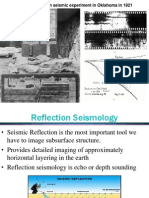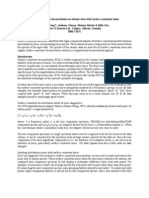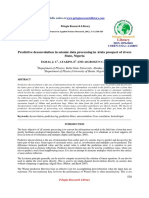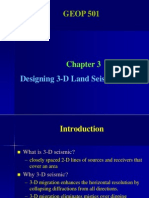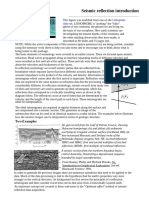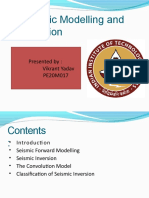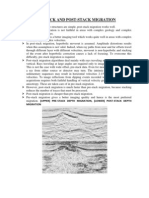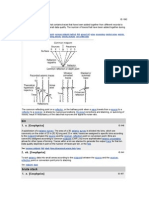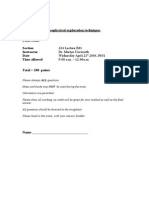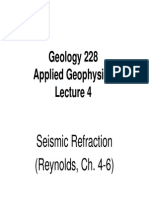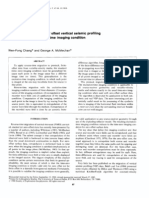Statics Correction Elevation
Statics Correction Elevation
Uploaded by
Andi MahriCopyright:
Available Formats
Statics Correction Elevation
Statics Correction Elevation
Uploaded by
Andi MahriCopyright
Available Formats
Share this document
Did you find this document useful?
Is this content inappropriate?
Copyright:
Available Formats
Statics Correction Elevation
Statics Correction Elevation
Uploaded by
Andi MahriCopyright:
Available Formats
1
Chapter 5 Static corrections
Elevation (field) statics
Elevation statics involve the computation and removal of the effect of different source
and receive elevations.
This involves bringing the source and receiver to a common datum, usually below the
elevation of the lowest source or receiver.
For this, we need a replacement velocity (Vr) for the material between the datum and
the source or receiver.
The replacement velocity is either assumed from prior knowledge of the area or can
be estimated from uphole times or direct arrivals.
The elevation static correction (tD) is given by:
tD = [(ES ZS - ED) + (ER ZR - ED)]/Vr, where, ES: ground elevation at shot location (from mean sea level), ZS: depth of shot (= 0 for a surface source), ER: ground elevation at receiver location (from mean sea level), ZR: depth of receiver (= 0 for a surface geophone), and ED: datum elevation (from mean sea level). (5.1)
tD is subtracted from the two-way traveltime of the trace belonging to that particular
source-receiver pair.
Figure.
Near-surface (weathering) corrections
After elevation statics correction, it is important to correct for the effect of variable
thickness and lateral velocity variation of the weathering layer.
The main methods used to correct for these effects are:
Uphole surveys. Refraction statics. Residual statics.
Uphole survey
A deep hole that penetrates below the weathering layer is used for this purpose. Several geophones are placed at various (known) depths in the hole. The geophone
locations must span the weathering and sub-weathering layers.
A shot is fired at the surface near the hole and the direct traveltimes to the geophones
are recorded.
A plot of the direct traveltimes versus the geophone depths can be used to compute
the velocities of the weathering and sub-weathering layers as well as the thickness of the weathering layer at that location.
This method attempts to construct a model of the weathering layer by estimating the
velocity and thickness of the weathering layer at several locations and interpolating between these locations.
Figure.
Refraction statics
This method is especially effective in estimating long-wavelength statics. Wavelength of statics refers to the width of the lateral (velocity or thickness) change
in the weathering layer relative to the spread length (maximum offset).
This method is used to construct a model of the weathering layer by estimating the
velocity and thickness of the weathering layer.
The following are some of the methods used for refraction statics calculation:
Delay-time methods. The generalized reciprocal method (GRM). Least-squares methods.
The first two methods involve picking first breaks, which is difficult, and require
specific raypath geometries, which might not be available.
The least-squares methods employ the same concepts used for the residual-statics
method, but use refraction rather than reflection data.
Residual statics
This method is especially effective in estimating short-wavelength statics. The most widely used method is the surface-consistent method.
Surface-consistent residual statics corrections:
The basic assumption of this method is that the static shifts are time delays that only
depend on the source and receiver locations on the surface, not on raypaths in the subsurface.
This assumption is valid only if all raypaths, regardless of source-receiver offset, are
vertical in the near surface.
The surface-consistent assumption is generally good because the weathered layer
usually has a low velocity and refraction towards the normal at its base tends to make raypaths vertical.
The total residual time shift, tijk, can be expressed as: tijk = ri + sj + Gk + Mk xij2, where ri: is the residual static time shift associated with the ith receiver, sj: is the residual static time shift associated with the jth source, Gk: is the difference in two-way traveltime at a reference CMP and the traveltime at the kth CMP, and Mk xij2: is the residual moveout that accounts for the imperfect NMO correction. (5.2)
Gk is a structural term, while Mk is a hyperbolic term. The purpose is to determine the unknowns ri, sj, Gk, and Mk from the known variables
tijk and xij.
Usually, there are more equations than unknowns; hence, we use least-squares
approach to minimize the error energy: E = ijk [(ri + sj + Gk + Mk xij2) - tijk]2. (5.3)
Residual statics correction in practice
In general, residual statics correction, in practice, involves the following three phases:
(1) Picking (calculating) the time shifts tijk. (2) Decomposition of tijk into receiver, source, structural, and residual terms.
(3) Application of derived source and receiver terms to traveltimes on pre-NMOcorrected CMP gathers.
(1) Picking: It means estimating the time shifts tijk from the data. The most widely used method is the pilot trace method, which consists of the following steps: (1) A CMP with good S/N ratio is gained and NMO-corrected using a preliminary velocity function. (2) A specific horizon (reflection, event) is selected. (3) The CMP gather is stacked. (4) Each individual trace in the gather is crosscorrelated with the stack trace. (5) Time shifts tijk(1), which correspond to maximum crosscorrelations, are picked. (6) Shift each original trace by its corresponding time shift tijk(1). (7) A preliminary pilot trace is constructed by stacking the time-shifted traces in the gather. (8) This pilot trace is, in turn, crosscorrelated with the shifted traces in the gather and new time shifts tijk(2) are computed. (9) Shift each once-shifted trace by its corresponding new time shift tijk(2). (10) (11) (12) The total time shift is given as: tijk = tijk(1) + tijk(2). A final pilot trace is constructed again by stacking the twice-shifted traces. This final pilot trace is crosscorrelated with the traces of the next gather to construct the preliminary pilot trace for that gather.
(13) The process is performed this way on all CMP gathers moving to left and right from the starting (reference) CMP. (14) The picked total time shifts (t ijk) are passed to the next phase (decomposition). The following parameters are important when picking the time shifts in practice: (a) Maximum allowable shift: v It should be greater than all possible combined shot and receiver shifts at any given location along the profile. v However, it should be less than the dominant period of the data in poor S/N ratio conditions. (b) Correlation window: v It should be chosen in an interval with the highest possible S/N ratio. v It should be as large as possible and outside the mute zone whenever possible. (c) Other considerations: v The residual moveout variations should not be large within the correlation window. v In areas of significantly poor S/N ratio, a second pass of residual statics corrections must be done. v A second residual statics correction pass means: 1. Do velocity analysis. 2. Do residual statics correction. 3. Do velocity analysis again. 4. Do residual statics correction again.
(2) Decomposition: It involves least-squares decomposition of the picked time shifts found in phase (1) into source, receiver, structural, and residual terms using equation (5.3). The procedure most widely used for solving the resulting system of linear equations is the Gauss-Seidel iterative procedure. (Not required): For more detail on the Gauss-Seidel iterative procedure, follow this link.
(3) Application: The individual static shifts associated with each source and receiver location are applied to the pre-NMO-corrected gather traces.
Appendix A Elevation Statics
ES Ground surface ZS ER ZR
Vr ES - ZS - ED
ER ZR - ED ED
(ES Z S ED ) + (ER Z R ED ) tD = Vr
Back
Appendix B Uphole Survey
DEPTH (M) 10 20 30 40 50 60 VELOCITY (M/S) 1000 1000 1000 2000 2000 2000 TIME (S) 0.010 0.020 0.030 0.035 0.040 0.045
Back
You might also like
- 1 - ENG 157 - Complete Module PDFDocument220 pages1 - ENG 157 - Complete Module PDFAlthea LayloNo ratings yet
- Homebrew Content - Monster A Day CompendiumDocument115 pagesHomebrew Content - Monster A Day CompendiumRenato Alves97% (88)
- Mamdouh Gadalla ViejoDocument389 pagesMamdouh Gadalla ViejoAngie CamposNo ratings yet
- Depth of InvestigationDocument8 pagesDepth of InvestigationGogot Pantja Parijogo100% (1)
- A Short Biography of Syed Muhammad LatifDocument3 pagesA Short Biography of Syed Muhammad LatifAizad Sayid100% (1)
- Source Code For Logistic Regression and Dijkstra's AlgorithmDocument1 pageSource Code For Logistic Regression and Dijkstra's AlgorithmArchita GogoiNo ratings yet
- Module 3 - InventoryDocument12 pagesModule 3 - InventoryJehPoyNo ratings yet
- Dynamic CorrectionDocument18 pagesDynamic CorrectionMajid AliNo ratings yet
- First Reflection Seismic Experiment in Oklahoma in 1921Document59 pagesFirst Reflection Seismic Experiment in Oklahoma in 1921Ezzadin BabanNo ratings yet
- Basic ProcessingDocument86 pagesBasic ProcessingRazi AbbasNo ratings yet
- Depth Conversion of Time Interpretations Volume ModelsDocument53 pagesDepth Conversion of Time Interpretations Volume ModelsSani TipareNo ratings yet
- Lab 06 - Static CorrectionsDocument4 pagesLab 06 - Static Correctionsapi-323770220No ratings yet
- Seismic Refraction For Class 2Document50 pagesSeismic Refraction For Class 2Adides Gidson SimanjuntakNo ratings yet
- Seismic Refraction For Class 2Document50 pagesSeismic Refraction For Class 2Jayanti TangdiomboNo ratings yet
- Lecture-10 - Sesmic Data ProcessingDocument13 pagesLecture-10 - Sesmic Data ProcessingusjpphysicsNo ratings yet
- Surface Consistent Deconvolution On Seismic Data With Surface Consistent NoiseDocument5 pagesSurface Consistent Deconvolution On Seismic Data With Surface Consistent NoiseEduardo LugoNo ratings yet
- Predictive Deconvolution in Seismic Data Processing in Atala Prospect of Riversstate NigeriaDocument10 pagesPredictive Deconvolution in Seismic Data Processing in Atala Prospect of Riversstate NigeriaSajanNo ratings yet
- GEOP 501: Designing 3-D Land Seismic SurveysDocument59 pagesGEOP 501: Designing 3-D Land Seismic SurveysMark MaoNo ratings yet
- Seismic ReflectionDocument21 pagesSeismic Reflectionvelkus2013No ratings yet
- Seismic Data Processing and InterpretationDocument15 pagesSeismic Data Processing and InterpretationmustafaNo ratings yet
- Gupco: Common Depth Point (CDP) and Common MidpointDocument3 pagesGupco: Common Depth Point (CDP) and Common MidpointmahmoudNo ratings yet
- Noise Attenuation Intmdt 03052018Document68 pagesNoise Attenuation Intmdt 03052018Pallav KumarNo ratings yet
- 09 DeconvolutionDocument19 pages09 DeconvolutionPhạm NamNo ratings yet
- Pe20m017 Vikrantyadav Modelling and InversionDocument18 pagesPe20m017 Vikrantyadav Modelling and InversionNAGENDR_006No ratings yet
- BHSDocument67 pagesBHSEdward FrankyNo ratings yet
- MATLAB NoteDocument15 pagesMATLAB Notemsalam2No ratings yet
- Why Spectral DecompositionDocument2 pagesWhy Spectral Decompositionanima1982No ratings yet
- GeophysicsDocument64 pagesGeophysicsrizkaNo ratings yet
- SeismicDocument8 pagesSeismicAhmed Magdy BeshrNo ratings yet
- Seismic StratigraphyDocument33 pagesSeismic StratigraphyAmrinder Sharma100% (2)
- Lab 04 - Seismic DeconvolutionDocument10 pagesLab 04 - Seismic Deconvolutionapi-323770220No ratings yet
- Pre-Stack and Post-Stack MigrationDocument4 pagesPre-Stack and Post-Stack MigrationMark MaoNo ratings yet
- N. (Geophysics) : Seismic Record Noise FoldDocument84 pagesN. (Geophysics) : Seismic Record Noise FoldRazi AbbasNo ratings yet
- 2-D SURVEY DESIGN - FinalDocument47 pages2-D SURVEY DESIGN - Finalasmita100% (1)
- Pre Stack Migration Aperture - An Overview: Dr. J.V.S.S Narayana Murty, T. ShankarDocument6 pagesPre Stack Migration Aperture - An Overview: Dr. J.V.S.S Narayana Murty, T. ShankarJVSSNMurty100% (1)
- II - Techniques in Structural Geology-SeismicDocument27 pagesII - Techniques in Structural Geology-SeismicAlionk GaaraNo ratings yet
- Theory of Seismic Imaging PDFDocument226 pagesTheory of Seismic Imaging PDFAngel Saldaña100% (1)
- Geophysics 224 Geophysical Exploration Techniques Final Exam Section Instructor Date Time AllowedDocument8 pagesGeophysics 224 Geophysical Exploration Techniques Final Exam Section Instructor Date Time AllowedSuraj KumarNo ratings yet
- Sonic PorosityDocument26 pagesSonic PorosityNagaraju JallaNo ratings yet
- Metode SeismikDocument105 pagesMetode SeismikMuzzammilAlMackyNo ratings yet
- Introduction To The Seismic Reflection Exploration MethodDocument85 pagesIntroduction To The Seismic Reflection Exploration MethodSumanyu DixitNo ratings yet
- Coherency InversionDocument16 pagesCoherency InversionSani TipareNo ratings yet
- Synthetic Seismogram PDFDocument3 pagesSynthetic Seismogram PDFOmar MohammedNo ratings yet
- Statics: Seismic Data Processing ElnusaDocument24 pagesStatics: Seismic Data Processing ElnusaamrymokoNo ratings yet
- Seismic RefractionDocument74 pagesSeismic RefractionAdrian Liviu BugeaNo ratings yet
- GEOL30005 Applied Geophysics: The Seismic MethodDocument20 pagesGEOL30005 Applied Geophysics: The Seismic MethodMartin NguyenNo ratings yet
- What Kind of Vibroseis Deconvolution Is Used - Larry MewhortDocument4 pagesWhat Kind of Vibroseis Deconvolution Is Used - Larry MewhortBayu SaputroNo ratings yet
- 3-D Seismic Attributes: Dan Gr. Vetrici and Robert R. StewartDocument30 pages3-D Seismic Attributes: Dan Gr. Vetrici and Robert R. Stewartmichael2k7849100% (1)
- Practical Seismic Interpretation For Petroleum Exploration 1689090368Document119 pagesPractical Seismic Interpretation For Petroleum Exploration 1689090368Eduardo LeaubonNo ratings yet
- Channel ElementsDocument16 pagesChannel ElementsMohamed Abd El-ma'boud100% (1)
- The Magnetic SurveyDocument15 pagesThe Magnetic Surveymelannie adanteNo ratings yet
- Parallel Seismic 2-D Reverse Time MigrationDocument4 pagesParallel Seismic 2-D Reverse Time MigrationEditor IJRITCCNo ratings yet
- Gassman TutorialDocument11 pagesGassman TutorialKristian TorresNo ratings yet
- Basics of Seismic Wave TheoryDocument154 pagesBasics of Seismic Wave TheoryYinfeng Dong0% (1)
- Basic Scheme of The Seismic Data ProcessingDocument17 pagesBasic Scheme of The Seismic Data ProcessingEmma KokakuNo ratings yet
- Lab 14 - Seismic RefractionDocument19 pagesLab 14 - Seismic Refractionsaurabh sharmaNo ratings yet
- Velocity Analysis and Statics CorrectionsDocument192 pagesVelocity Analysis and Statics CorrectionsKim PerezNo ratings yet
- Geometrical AttributesDocument129 pagesGeometrical AttributesMirza Ali100% (1)
- Seismic Facies and Hydrocarbon Potential of Carbonate Reservoirs in Ramp SettingsDocument13 pagesSeismic Facies and Hydrocarbon Potential of Carbonate Reservoirs in Ramp SettingsRuth Santos NaranjoNo ratings yet
- 3 CoherenceDocument28 pages3 CoherenceSagnik Basu RoyNo ratings yet
- Gph301 Lect2 Seismic1 ElwaheidiDocument29 pagesGph301 Lect2 Seismic1 ElwaheidiRoland Rawlins IgaborNo ratings yet
- Migration of Common-Shot Gathers: Moshe Reshef and Dan KosloffDocument8 pagesMigration of Common-Shot Gathers: Moshe Reshef and Dan KosloffsputriNo ratings yet
- Turning-Ray Tomography For Statics SolutionDocument4 pagesTurning-Ray Tomography For Statics Solutionpankaj sharmaNo ratings yet
- Depth Conversion of Time InterpretationsDocument58 pagesDepth Conversion of Time InterpretationsAyu Indri FirdaniNo ratings yet
- Reverse-Time Migration of Offset Vertical Seismic Profiling Data Using The Excitation-Time Imaging ConditionDocument18 pagesReverse-Time Migration of Offset Vertical Seismic Profiling Data Using The Excitation-Time Imaging ConditionjfungjNo ratings yet
- Brian Rotman Signifying Nothing The Semiotics of ZeroDocument59 pagesBrian Rotman Signifying Nothing The Semiotics of ZeroGonzalo LuyoNo ratings yet
- 1 PDFDocument10 pages1 PDFSivakumarNo ratings yet
- Lesson Plan Healthy Life, Food and Sport RO CCDocument9 pagesLesson Plan Healthy Life, Food and Sport RO CCDeo HortilanoNo ratings yet
- Conciliation NotesDocument6 pagesConciliation NotesSuraj KumarNo ratings yet
- Lab # 5: Relational Operators, Logical Operators and DecisionsDocument20 pagesLab # 5: Relational Operators, Logical Operators and DecisionsShujaAmjadNo ratings yet
- Culture: - SocietyDocument51 pagesCulture: - SocietyJan Rovyn JavierNo ratings yet
- Pid KidsDocument46 pagesPid KidsSamrandNo ratings yet
- How AI Will Reshape Market Access - 20230405 SDocument52 pagesHow AI Will Reshape Market Access - 20230405 Schaitanya0anandNo ratings yet
- FINAL - Sem 3 Reflection PaperDocument4 pagesFINAL - Sem 3 Reflection PaperSage LingatongNo ratings yet
- Iso 6976Document1 pageIso 6976Waleed El-azabNo ratings yet
- Factors Influencing Speech Delay in ChildrenDocument10 pagesFactors Influencing Speech Delay in ChildrenDhinar WidiastutiNo ratings yet
- Jurnal Aspergillus OryzaeDocument5 pagesJurnal Aspergillus Oryzaedinna_dinunNo ratings yet
- Answer KeyDocument2 pagesAnswer KeyPatricio IsaranNo ratings yet
- I. Answers To Questions: Cost Accounting and Control - Solutions Manual Cost Terms, Concepts and ClassificationsDocument18 pagesI. Answers To Questions: Cost Accounting and Control - Solutions Manual Cost Terms, Concepts and ClassificationsYannah HidalgoNo ratings yet
- Heidegger's God: Against Caputo, Kearney, and Marion: Philosophy & Theology 26:2 (2014)Document11 pagesHeidegger's God: Against Caputo, Kearney, and Marion: Philosophy & Theology 26:2 (2014)TomasineNo ratings yet
- OriflameDocument42 pagesOriflamemanuNo ratings yet
- National Water and Sewerage Corporation: BackgroundDocument13 pagesNational Water and Sewerage Corporation: BackgroundBusingye ElizabethNo ratings yet
- Foundations of Political ScienceDocument19 pagesFoundations of Political SciencenupurNo ratings yet
- Lamaran Iklan Dan ContohDocument3 pagesLamaran Iklan Dan ContohChristy Setiawan PurbaNo ratings yet
- Microsoft Office 2016 - Key InstallationDocument1 pageMicrosoft Office 2016 - Key InstallationHaliryNo ratings yet
- Festival DanceDocument49 pagesFestival DanceErika MaeNo ratings yet
- Lecture 2. Lecture 1 HT For Students 2023-03-23 18 - 53 - 24Document26 pagesLecture 2. Lecture 1 HT For Students 2023-03-23 18 - 53 - 24Kashkol testNo ratings yet
- Whats New in Visual FoxPro 8.0 Chapter 06Document24 pagesWhats New in Visual FoxPro 8.0 Chapter 06APP EXCELNo ratings yet
- The Brief Assessment of Cognition in Schizophrenia. Normative Data For The Italian PopulationDocument9 pagesThe Brief Assessment of Cognition in Schizophrenia. Normative Data For The Italian PopulationMAGALYNo ratings yet
- Physics PracticalDocument24 pagesPhysics PracticalPeddini Pradeep KumarNo ratings yet








